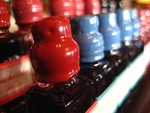Tips for Using and Maintaining Your Laboratory’s Freeze Dryer
Keep your lab’s freeze dryer running smoothly with our expert tips on care and maintenance, including oil changes and vacuum leak fixes.
Join Us
Sign up for our feature-packed newsletter today to ensure you get the latest expert help and advice to level up your lab work.
Search below to delve into the Bitesize Bio archive. Here, you’ll find over two decades of the best articles, live events, podcasts, and resources, created by real experts and passionate mentors, to help you improve as a bioscientist. Whether you’re looking to learn something new or dig deep into a topic, you’ll find trustworthy, human-crafted content that’s ready to inspire and guide you.

Keep your lab’s freeze dryer running smoothly with our expert tips on care and maintenance, including oil changes and vacuum leak fixes.

Learn about what reagents are usable past their chemical expiry date, how can you check if they are still okay, and which ones you should throw out.

The more expensive your lab centrifuge, the more sensitive and the easier it is to break. What can we do to give these pricey monsters a long, successful tenure in the lab? Read our 5 easy tips.

Performing successful experiments is a crucial skill for scientists. We’ve rounded up our top tips to help you achieve perfect procedures!

Not every lab has the cash to shell out on fancy equipment. We share some trusty lab hacks and welcome you to share your own with us.

Imagine that you want to test the efficiency of an antimicrobial treatment in inhibiting a certain bacterial pathogen. As part of the experiment, you expose the bacteria to the treatment and monitor the cultivability of the microorganism by counting the number of colony forming units (CFU) formed on culture media. If the microorganism is sensitive…

Negative staining of proteins is a versatile tool for structural biology. The sample preparation protocol is simple: the sample is embedded in a heavy metal stain that gives rise to increased specimen contrast. Thus, negative staining is a very convenient method to assess sample homogeneity, formation of macromolecular complexes, or quality of protein preparation. Conventional…

Pipetting all day? Scrolling and scrolling through Excel columns trying to make sense of your data? Spending hours at the microscope because your boss wants Nature-worthy pictures? It’s not uncommon that performing lab work forces you into unhealthy postures, and after a day at work your spine begs for mercy. How Your Posture Suffers on…

You’ve cultured your cells and completed your treatments, now it’s time to harvest them and proceed to the downstream effects. Cell lysis is the crucial stage that determines if your experiment has a chance of producing the data that you have been waiting for. Part of the starting biological material is inevitably lost on each…

I was so excited to start using 384-well plates for my assays. With so many wells, these plates are useful for testing many conditions in parallel, as required in ELISAs, siRNA library screens, and drug treatment dilutions. However, I quickly learned that pipetting in these plates is more complicated than I thought. This article contains…

Bubbles isn’t just the name of my favorite cartoon character from Power Puff girls, or just the best activity for a kid to play with, in general. In my adult world, they stand for a whole lot more, but can still cause extreme emotions. At the lab bench, seeing bubbles brings happiness or sadness depending…

If you are working in a scientific laboratory, it is very important to be aware of the various types of water available, because the purity may not be acceptable for your specific experimental application. In most labs, there are generally two types of water piped in to the sinks: Industrial Water Industrial water is non-potable…

It is never too late to take proactive measures to protect your research budget in the event of a funding lapse.

As a researcher, it’s satisfying to manage your own projects and do the bench work yourself. After all, if you don’t have experience with a technique, you’re usually expected to figure it out (with or without direct supervision). In some situations, dealing with difficult molecular techniques is simply part of the job description. The scientific…

An anti-cancer drug or antibody drug conjugate (ADC) screening assay is the first step to establish the utility of a drug candidate in killing cancer cells. Nevertheless, these assays are time consuming and tedious. The purpose of this article is to make things easier when you are required to set up these in vitro screening…

So, you have successfully cloned your gene of interest and are eager to purify buckets of protein. No matter your eventual application—kinetic experiments using a SPR instrument, structural analysis using X-ray crystallography, or any other experiment—you’ll need to express your protein first. Now, it’s time to put your expression plasmid into E. coli and get…

While using human clinical samples in your research can provide robust and heterogeneous results applicable to larger portions of the population, working with these samples presents its own set of challenges. Here are some tricks I have learned to help isolate and grow your cells of interest while eliminating stromal, blood, or other undesired contaminants….

Speed up your SDS-PAGE with our time-saving tips and tricks!

There’s piloting a brand new technique for the first time. Then, there’s jumping through hoops trying to get an established lab technique to work. The former, in contrast to the latter, is expected to be fraught with hardships. Yet troubleshooting an old lab technique that isn’t working anymore, is frustrating at a whole new level….

When I began a master’s program in 2008, the lab task I hated more than anything was running agarose gels for DNA. Something so simple, ubiquitous, and necessary gobbled up more hours in the lab than I care to remember. Even though we added the DNA stain directly to the molten agarose and didn’t have…

You’ve tried all the usual stuff, and checked the primer sequences twice, but still can’t get that PCR fragment amplified. It’s time to enter the strange world of PCR additives. Over the years a variety of additives have been shown to enhance PCR reactions in certain situations. Here is a summary of some of the…

So, you’ve extracted your precious RNA and want to check its quality on a gel. Conventionally, you would run a formaldehyde gel, which is messy and requires a lot of prep. Plus, it is a huge undertaking in terms of time (and money) if all you want to do is just check the quality of…

In Part 1 of this article, I introduced you to using code for basic image manipulation in ImageJ and working with the command recorder to expand your coding vocabulary. I covered how to make a simple macro, how to edit it and then save it to be run again another time. If you skipped the…

Here’s a tip that you may find useful if you are expressing proteins in E.coli using a lac promoter-based expression system, e.g. pET, in LB medium (L-broth). Lac expression systems are typically induced in the lab using IPTG (isopropyl-beta-D-thiogalacto- pyranoside), which is a non- hydrolyzable analog of lactose, the natural inducer of the lac operon….

One of the most crucial steps in any cloning procedure is the preparation of the vector. Get it wrong and your chances of success will be drastically reduced. The overall aim for a good vector preparation is to obtain a fairly concentrated stock of undamaged, fully digested plasmid DNA that is free from contaminants. Missing…

ECL can be an expensive reagent in a lab. Why not make your own? Hopefully, this quick, simple and cheap solution will be of help to you!

We are pleased to announce that the famous maid of microbiology, dear old Aunt Yersinia, has agreed to start writing a microbiology and molecular biology advice column for Bitesize Bio. She will be free to answer your most pressing questions sent to: auntyersinia@bitesizebio.com By way of introduction, Aunt Yersinia is bestowing 8 spores of knowledge garnered…

One of our readers posted the following question to us and we decided to pass it along to everybody’s favorite microbiology expert, Aunt Yersinia: For one year I am working in different research laboratories, after I got from school. I keep wondering why EVERYBODY is using pre-made Agar solutions for pouring plates, and EVERYBODY is…

If you want a more efficient, cheaper way to do bacterial transformation, you are definitely going to like this article.

Rumour has it that many people who work in a lab enjoy cooking. And, when asked by a non-biologist family member how they spend their days in the laboratory, molecular biologists might answer that doing experiments is similar to cooking. Apart from the organisational parallels that can be drawn between following a protocol and a…

Microcentrifuges are pretty much the epitome of efficiency, but I have a couple of suggestions that may make using this instrument even easier. Divide by ThreeNot only is the number of tubes a microcentrifuge can hold divisible by two, but almost always by three as well. How does this help you? If you have an…

We recently had a feature from Jode on everyday equipment that you can use in the lab, but what about the other way around? Do you ever take a look at what you’re doing in the lab and think, “Wow, this would really come in handy at home?” Here are a few of the things…

Find out how to build a plate centrifuge using a salad spinner. Gathering the components is as complicated as it gets!

Looking for cheaper or faster solutions in the lab? Here’s our top 10 list of ways to use everyday items to make gadgets and for low-tech solutions for the lab.

For identifying positive clones from a plasmid cloning procedure, the routine of performing a mini-prep and then checking the putative clones by restriction digestion is most commonly used. Of course, if you need to screen a large number of clones, another option is a colony PCR to identify positives, followed by restriction digests to confirm….

Get awesome pictures of your DNA gels with a standard digital camera and an orange filter. Here’s how.

The eBook with top tips from our Researcher community.